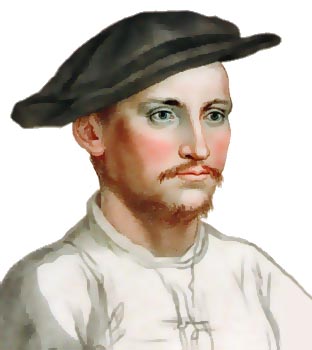 |
 |
|||
|
|
Sir Philip Hoby was son of William Hoby of Leominster in Herefordshire, by his first wife, Katherine Forster. His zeal for the Reformation recommended him to King Henry VIII and, during 1535 and 1536, he was employed in the diplomatic service at the Courts of Spain and Portugal. In 1542, Hoby, being then one of the gentlemen ushers of the King's Privy Chamber, was authorised, along with Sir Edward Kerne and Dr. Peter, to apprehend certain persons suspected of being Jews and, on 4th February in that year, he laid before the Privy Council, the books containing their examinations and inventories of their goods. On 18th March 1543, however, Hoby was, with two others, committed to the Fleet Prison for maintaining one Thomas Parson, a clergyman who held "evil opinions" touching the sacrament of the altar, but was discharged six days later. He then took part in the Siege of Boulogne and was rewarded with knighthood for his services, immediately after the conquest of the town, on 30th September 1544. He was, further, granted certain houses in London, which he appears to have, afterwards, conveyed to the Drapers' Company for the purpose of providing dowries yearly of four maiden orphans. Sir Philip was, likewise, liberally rewarded with monastic spoils. On 12th May 1545, he was appointed Master of the Ordnance in the North. In April 1548, he succeeded Thomas Thirlby, Bishop of Westminster, as ambassador resident at the court of the Holy Roman Emperor, Charles V. Upon his returning to England for a brief holiday, in October 1549, he conducted the negotiations between the Councils at Windsor and London in regard to the Protector Somerset; and contrived that the Duke should fall into the hands of the Earl of Warwick. With the Lord Warden, Sir Thomas Cheyne, he was then despatched to Charles V to declare the causes of Somerset's removal. In April 1551, he was appointed, with the Marquis of Northampton and others, to discuss, in Paris, the marriage then proposed between King Edward VI and Elizabeth, the daughter of King Henry II of France. He departed thither, says King Edward in his 'Journal,' on 15th May, attended by "ten gentlemen of his own, in velvet coats and chains of gold". In January 1552, Hoby, together with Thomas Gresham, was sent to Antwerp to negotiate the payment of certain moneys owing to the Fuggers. He was, afterwards, frequently employed in negotiating loans with the wealthy merchants of Antwerp. In the following February, he was despatched to Mary, Queen-Regent of Flanders, to complain of certain infringements upon in the Naval and commercial interests of England. A copy of his instructions is preserved in the Harleian manuscripts. In accordance with Henry VIII's wish, Hoby was made Master of the Ordnance and was admitted to the Privy Council in March 1552. The manor of Bisham Abbey in Berkshire was also bestowed on him, greatly to the disgust of its owner, Anne of Cleves, who found herself obliged to swap it for alternative lands in Suffolk. During the King's progress in July 1552, Hoby was left at the Tower of London, in charge of the metropolis. In April 1553, with Thirlby and Sir Richard Morysine, he was sent to Charles V to endeavour to mediate a peace between him and Henry II of France. In the ensuing May, he was chosen ambassador resident in Flanders. One of the few state papers issued during the nine days' reign of Lady Jane Grey was addressed to Hoby, and continued him and Morysine in their posts as ambassadors with the emperor at Brussels (12th July 1553). Hoby and Morysine, in reply to the council, termed Lady Jane's husband, Lord Guilford Dudley, King. When Queen Mary acceded to the throne, the council recalled Hoby and Morysine. Hoby, however, despite his protestantism, soon regained his offices and the Royal favour. In June 1554, he was again sent to Brussels on a diplomatic mission. Owing to failing health, he obtained leave of absence to try the water at Liege and the baths of Pau. By June 1555, he was staying with Sir John Cheke, also an invalid, at Padua. In the November following, he visited his friend Sir John Masone, the English ambassador at Antwerp and, a few days later, had a long interview with King Philip at Brussels, who assured him that he might firmly rely on his favour, Hoby having supposed that the King hated him "for the profession he made of being at heart exclusively English". He returned home in January 1555-6, bearing with him a consolatory message from Philip to Mary. Sir Philip died at his house in Blackfriars (Westminster) on 31st May 1558 and was buried adjoining his Berkshire home, in Bisham Church. His body was removed several years after to a chapel then newly erected in another part of the building as a family mausoleum by Elizabeth, widow of his half-brother, Sir Thomas Hoby. A superb monument to the memory of the two brothers remains there, with epitaphs written by Lady Hoby in English and Latin verse. Hoby married Elizabeth the daughter of Sir Walter Stonor, and having no issue, left Bisham to his half-brother. From his private letters to Lord Burghley, he appears to have been an amiable, cultured man. He was the friend of Titian and Pietro Aretino, and when the latter dedicated one of his books to Henry VIII in 1546, Hoby presented Aretino with a gratuity from the King. Heavily Edited from Sidney Lee's 'Dictionary of National Biography' (1891)
|
|||
| © Nash Ford Publishing 2001. All Rights Reserved. | ||||



 Sir
Philip Hoby (1505-1558)
Sir
Philip Hoby (1505-1558)